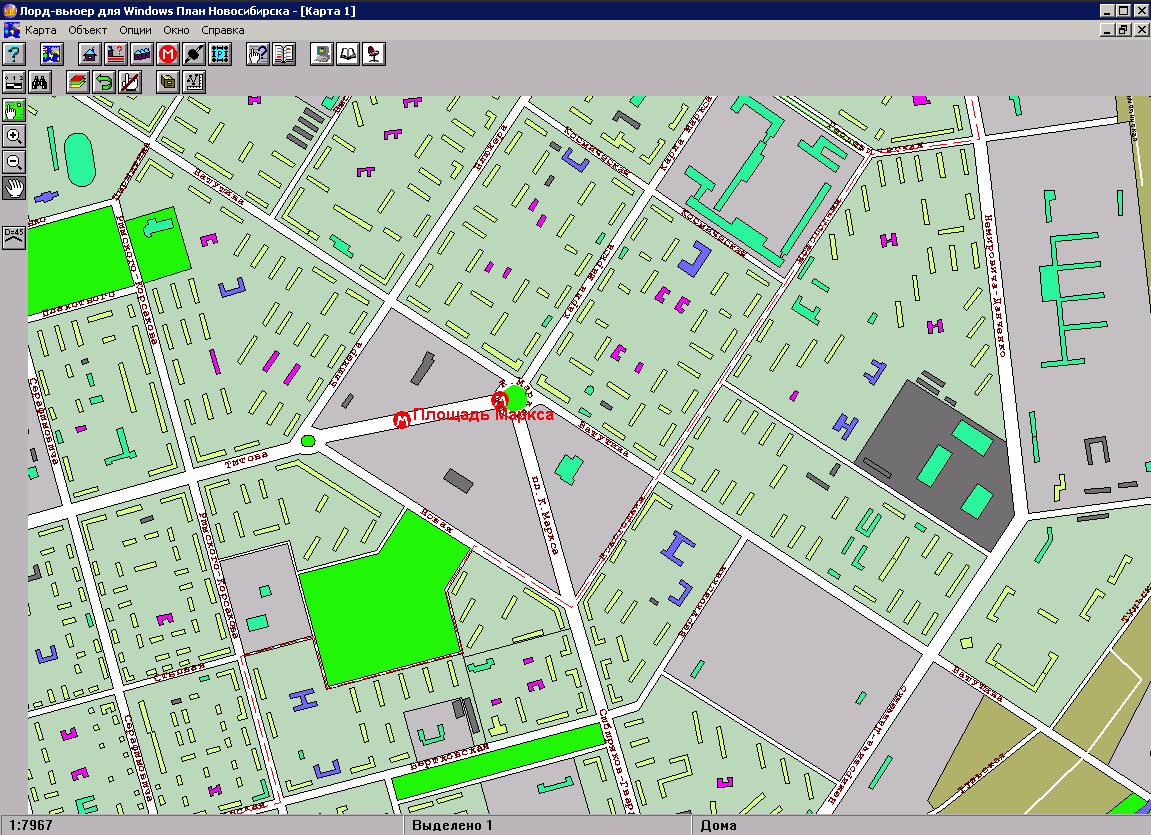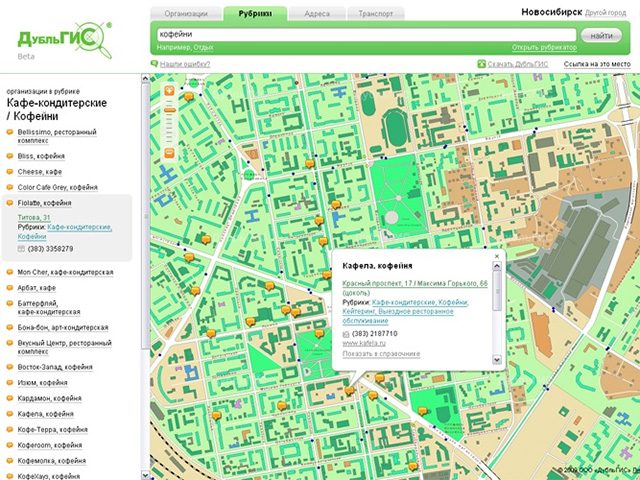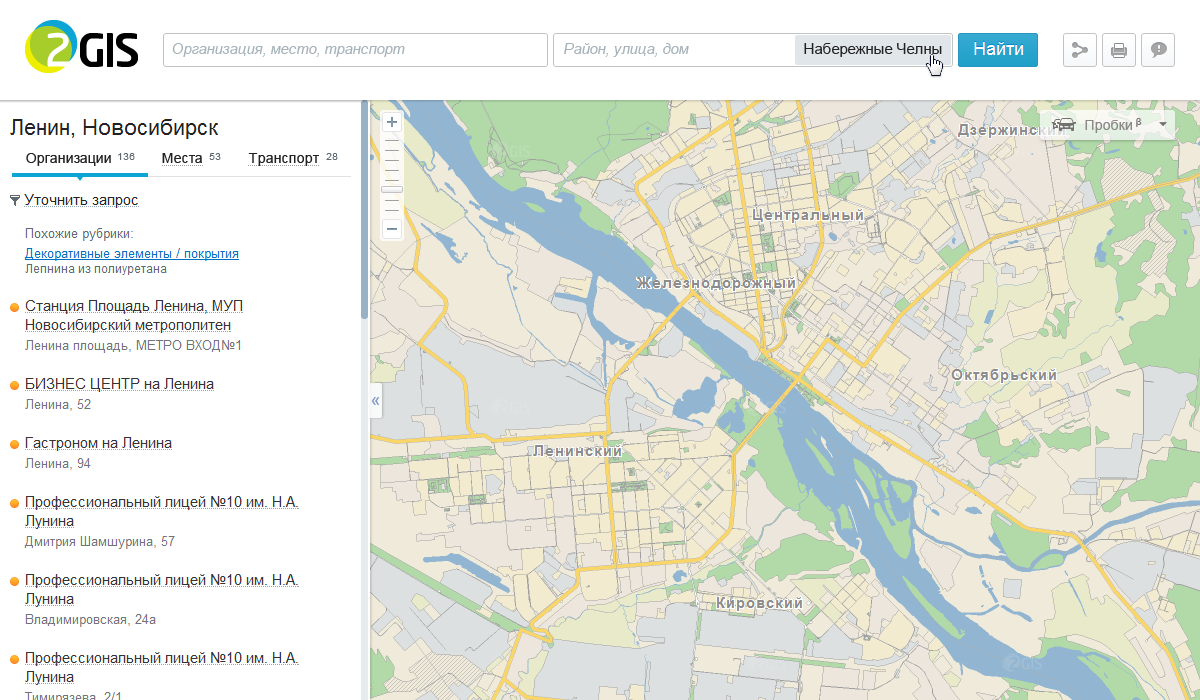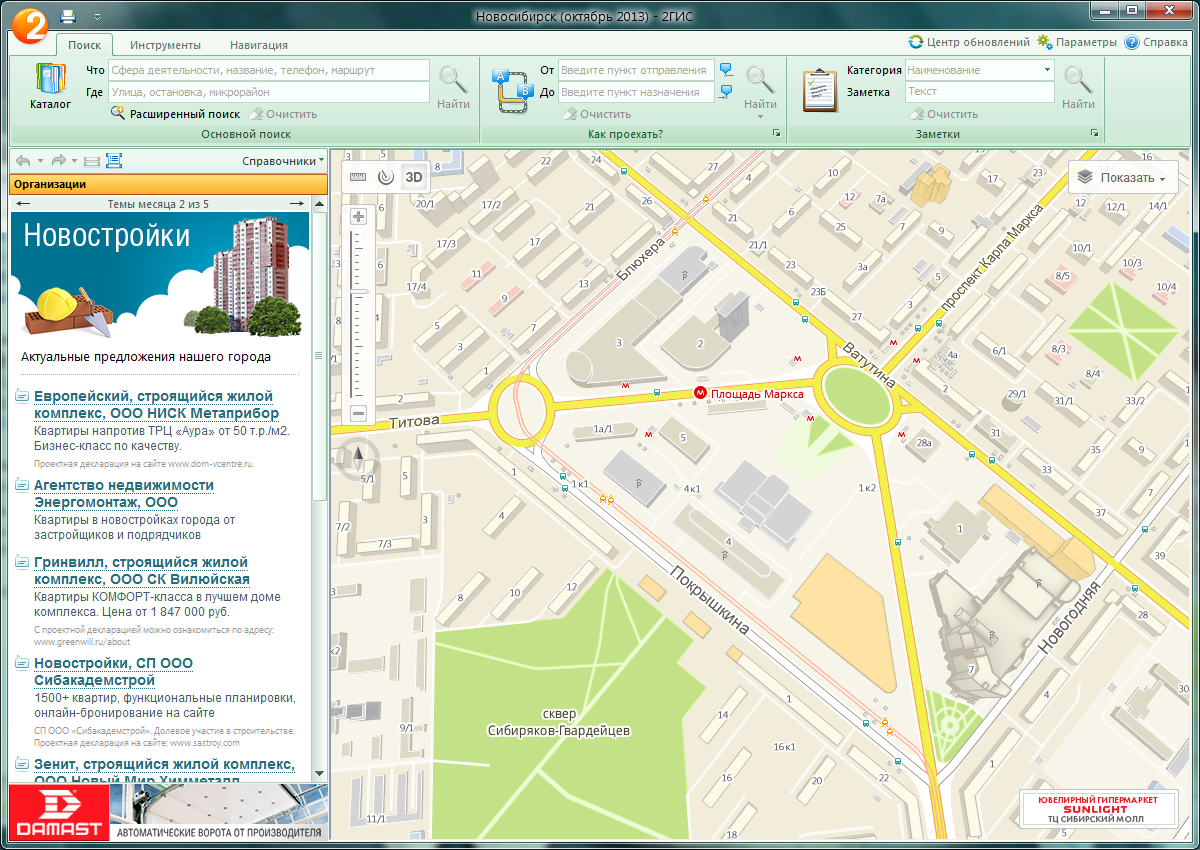2GIS: yesterday, today, tomorrow
In the 90s, most of the cards people used were large and paper. Electronic GIS (geographic information systems) already existed, but in the dungeons of research institutes and were made by professionals for their own purposes.
A little later, computers became more or less accessible, ceasing to be something elite or purely scientific. Programs began to appear for all. So, in 1999, the "Novosibirsk Scheme" appeared. It was an electronic map based on the professional GIS Lordview. Perhaps the first of its kind, with a target audience among ordinary users.
Interface and usability ... corresponded to the time of release of the program.

How 2GIS changed and what will happen tomorrow can be found under the cut.
Based on the very same Lordview, the guide “Construction companies of Novosibirsk” is published. Even later, this resulted in the concept of a map of the city, combined with a directory of organizations.
Actually, the name 2GIS: a geographic information system plus a city information guide.
At first the program was sold on CD, and, of course, it was pirated by everyone. But a way out of the situation was found. Obvious today, but bold enough for the realities of those days - to make the program completely free and make money on something else. Advertising in the directory has become something else - this model works in 2GIS to this day.
So there was DublGIS 2.0. In addition to being free to download from the site, it has changed significantly visually. A more attractive and convenient (for that time) interface was made, information on public transport and a green map remembered by many were added.

In the yard is the middle of the two thousandth. The peculiar sounds of dial-up connections are supplanted by fast dedicated Internet access. We release an online version of DublGIS. From that moment, it became possible to choose the right company or find something on the map from any computer that is simply connected to the network. In the spirit of the times, the map was drawn on the fly, which caused some nuances with performance. At the same time, 40 people could use Online. In future versions, this problem was solved using pre-generated tiles.

Further development of 2GIS followed the path of simplifying UX and improving design.
DoubleGIS 3.0 was designed to simplify the handling of the program. The step that was debatable at that time was the introduction of the ribbon-bar, as in the recently released Office 2007. Of course, the first reaction of users was negative, we were asked to "return everything as it was." But over time, the criticism came to naught and everyone appreciated the convenience.

In parallel, we developed 2GIS Online, version 2.0 was released. The product became faster and got rid of visual noise.

And then, almost simultaneously, three key events take place: DoubleGIS turns into 2GIS, comes to Moscow and says goodbye to a peculiar, but it has become a native to many green card.

In Moscow, 2GIS immediately came out in beige. In other cities, the process of rejecting the green card began with 2GIS Online, which, meanwhile, has evolved to version 3.0.

Changing the color scheme alone was clearly not enough. A cardinal redesign of the cards was required, as the available ones did not meet modern requirements. It was time to drop the existing one and start all over again. A bold but necessary decision.
As a result, in the spring of 2012 new cards appeared in 2GIS products. Of course, not without reaction in the spirit of "Durov, return the wall." But people are conservative and we were ready for this.
We redrawn everything that could be redrawn, replaced the fonts and made a full-fledged 3D engine in 2GIS for PC, supporting it with 3D models of the most famous buildings.

But there is no limit to perfection. There is always something that can be improved. And we are constantly working on it. We have already introduced some of the upcoming improvements: cool blue pins-markers.
Of course, this is not all we have been working on lately. An exciting event for us will be held at Digital October tomorrow. On it we will show the new 2GIS and the latest developments of the company.
If you want to visit, then write to Maxim . Tell us in a letter who you are, what you do, and why you are interested in attending an event.
For those who can’t get there, but there is a desire to find out about new products, you can watch the broadcast on the Digitaloctober website or here on Khabr. We are waiting for you in our next post.
A little later, computers became more or less accessible, ceasing to be something elite or purely scientific. Programs began to appear for all. So, in 1999, the "Novosibirsk Scheme" appeared. It was an electronic map based on the professional GIS Lordview. Perhaps the first of its kind, with a target audience among ordinary users.
Interface and usability ... corresponded to the time of release of the program.

How 2GIS changed and what will happen tomorrow can be found under the cut.
Long
Based on the very same Lordview, the guide “Construction companies of Novosibirsk” is published. Even later, this resulted in the concept of a map of the city, combined with a directory of organizations.
Actually, the name 2GIS: a geographic information system plus a city information guide.
At first the program was sold on CD, and, of course, it was pirated by everyone. But a way out of the situation was found. Obvious today, but bold enough for the realities of those days - to make the program completely free and make money on something else. Advertising in the directory has become something else - this model works in 2GIS to this day.
So there was DublGIS 2.0. In addition to being free to download from the site, it has changed significantly visually. A more attractive and convenient (for that time) interface was made, information on public transport and a green map remembered by many were added.

Yesterday
In the yard is the middle of the two thousandth. The peculiar sounds of dial-up connections are supplanted by fast dedicated Internet access. We release an online version of DublGIS. From that moment, it became possible to choose the right company or find something on the map from any computer that is simply connected to the network. In the spirit of the times, the map was drawn on the fly, which caused some nuances with performance. At the same time, 40 people could use Online. In future versions, this problem was solved using pre-generated tiles.

Further development of 2GIS followed the path of simplifying UX and improving design.
DoubleGIS 3.0 was designed to simplify the handling of the program. The step that was debatable at that time was the introduction of the ribbon-bar, as in the recently released Office 2007. Of course, the first reaction of users was negative, we were asked to "return everything as it was." But over time, the criticism came to naught and everyone appreciated the convenience.

In parallel, we developed 2GIS Online, version 2.0 was released. The product became faster and got rid of visual noise.

And then, almost simultaneously, three key events take place: DoubleGIS turns into 2GIS, comes to Moscow and says goodbye to a peculiar, but it has become a native to many green card.

In Moscow, 2GIS immediately came out in beige. In other cities, the process of rejecting the green card began with 2GIS Online, which, meanwhile, has evolved to version 3.0.

Today
Changing the color scheme alone was clearly not enough. A cardinal redesign of the cards was required, as the available ones did not meet modern requirements. It was time to drop the existing one and start all over again. A bold but necessary decision.
As a result, in the spring of 2012 new cards appeared in 2GIS products. Of course, not without reaction in the spirit of "Durov, return the wall." But people are conservative and we were ready for this.
We redrawn everything that could be redrawn, replaced the fonts and made a full-fledged 3D engine in 2GIS for PC, supporting it with 3D models of the most famous buildings.

But there is no limit to perfection. There is always something that can be improved. And we are constantly working on it. We have already introduced some of the upcoming improvements: cool blue pins-markers.
Tomorrow
Of course, this is not all we have been working on lately. An exciting event for us will be held at Digital October tomorrow. On it we will show the new 2GIS and the latest developments of the company.
If you want to visit, then write to Maxim . Tell us in a letter who you are, what you do, and why you are interested in attending an event.
For those who can’t get there, but there is a desire to find out about new products, you can watch the broadcast on the Digitaloctober website or here on Khabr. We are waiting for you in our next post.
